Fix Windows and Linux errors showing different time at dual boot
When booting Windows and Linux, you may notice that it is not possible to synchronize the system clock between these two operating systems. Although you have changed the clock on an operating system, it still does not fix the problem on the other operating system. This is because these two operating systems use different timing methods. This article will show you how to fix Windows and Linux errors showing different time at dual boot.
How to fix time difference when booting Windows and Linux dual
- Why do the two operating systems show different time?
- How to fix Windows and Linux errors displays different times when dual booting
- Method 1: Adjust to Linux using time on the computer
- Method 2: Adjust Windows to use UTC
Why do the two operating systems show different time?
The computer stores the current time on the clock in the motherboard. This allows the computer to keep track of time even when it is turned off. To calculate time zones, different operating systems use different methods. Windows assumes the time the computer is stored in the motherboard, so it does not apply any time zones. On the other hand, Linux will interpret the time on the motherboard as UTC (also known as Greenwich Mean Time) and apply a time zone to display the time on the computer.
Both operating systems are fully independent. The problem occurs when users dual-boot the system, running Windows and Linux on the same motherboard. When operating systems are forced to share a timeline, the clocks will not synchronize.
How to fix Windows and Linux errors displays different times when dual booting
Method 1: Adjust to Linux using time on the computer
The safest method for Linux and Windows to display at the same time is to change the Linux timing method. It works on all distributions of Linux using systemd, including Ubuntu, Fedora, Red Hat, Debian and Mint. Windows time changes often work well, but sometimes it can lead to instability in third-party software.
Open the Terminal window and run the following command:
timedatectl set-local-rtc 1 --adjust-system-clock

This command will tell the system to use the motherboard storage time as the computer time. Linux will no longer apply time zone adjustments to the storage time on the motherboard. As a result, the clock will be synchronized. If you want to reverse the command, just change 1 to 0:
timedatectl set-local-rtc 0 --adjust-system-clock
Method 2: Adjust Windows to use UTC
You can also change the way Windows views the time system. This adjustment will cause Windows to use the time stored on the motherboard as UTC. Although this method generally works well, some of the time-based applications of the motherboard may be affected, so it is sometimes difficult to track errors.
Step 1. Disable " Set time automatically " in " Time & Language " in the Settings application. This will prevent Windows from deleting the changes we are about to make.
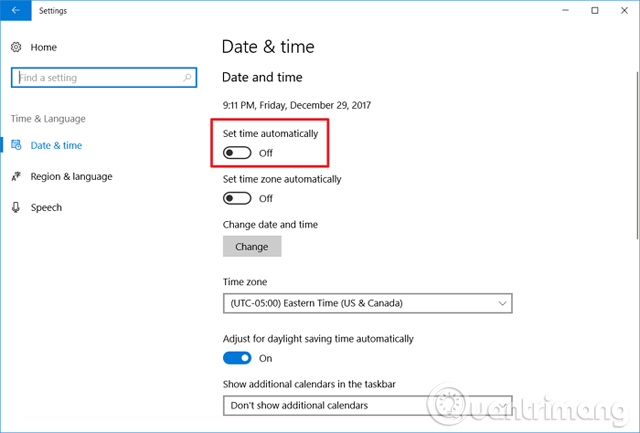
Step 2. Open Registry Editor by typing regedit into the Start menu.
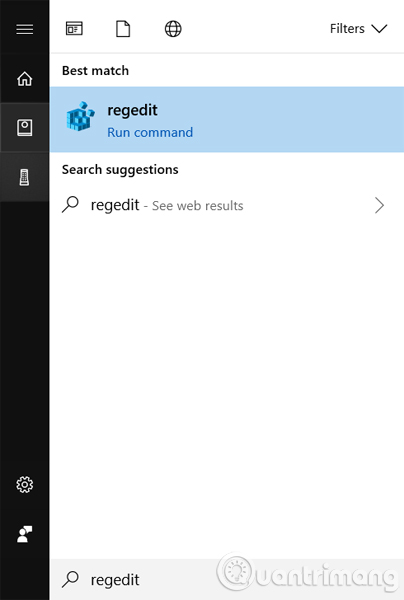
Step 3. Find the following registry key in the left pane of Registry Editor by pasting the following line into the address bar of the registry editor:
HKEY_LOCAL_MACHINESystemCurrentControlSetControlTimeZoneInformation

Step 4. Right-click the " TimeZoneInformation " key in the left pane and select " New -> DWORD (32-bit) Value " from the context menu.
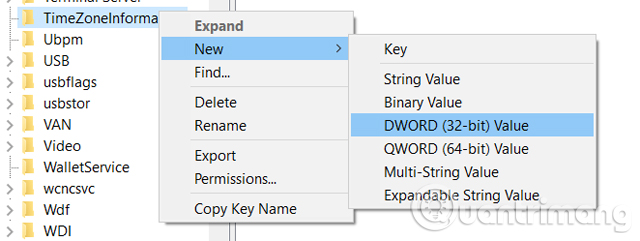
Step 5 . Name the new value "RealTimeIsUniversal".
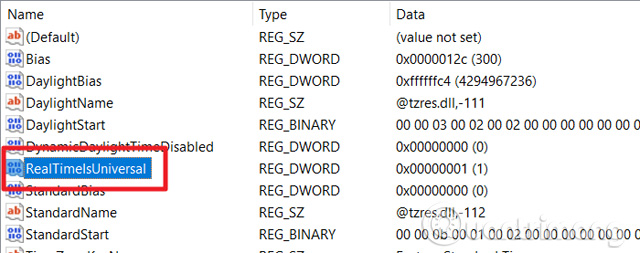
Step 6. Double click on the value just created, set the value to "1" and click " OK ".
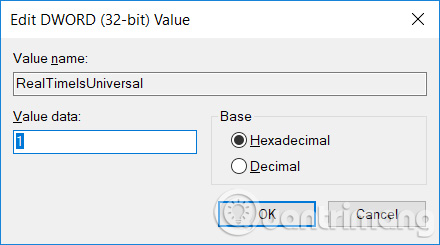
The safest way to synchronize the system clock in a dual-boot system is to adjust the way Linux uses time. If this doesn't work (or if you're using macOS instead of Linux), you can also edit the Windows registry to change the way Windows uses the time of the motherboard.
I wish you all success!
See more:
- Use parallel Windows 7 and Windows 8 on PC
- Install and start Windows XP and Vista on one computer
- Windows 8 security feature prevents dual booting with Linux
You should read it
- How to create dual boot Linux and Windows 10 on Linux
- 7 risks when booting dual operating systems Windows and Linux
- Steps to fix dual boot option not showing in Windows 10
- How to install Kali Linux dual boot on macOS
- How to dual-boot Raspberry Pi with BerryBoot
- How to install dual boot Windows 10 and Windows Server
- Why are smatphone now using 2 SIM technology with 2 standby waves but not 2 SIMs at the same time?
- Windows 8 security feature prevents dual booting with Linux
May be interested
- How to Dual Boot a Compatible Linux Distro with Windows 8
 looking to dual boot ubuntu (or other compatible linux distros) with a windows 8 pc or laptop? this is the best and possibly the simplest, most straight forward way to do it! assuming you have a windows 8 pc or laptop and an ubuntu 64-bit...
looking to dual boot ubuntu (or other compatible linux distros) with a windows 8 pc or laptop? this is the best and possibly the simplest, most straight forward way to do it! assuming you have a windows 8 pc or laptop and an ubuntu 64-bit... - Use parallel Windows 7 and Windows 8 on PC
 if you have a pc running windows 7 but aren't sure if you're ready to upgrade to windows 8, a dual-boot system might be a good solution.
if you have a pc running windows 7 but aren't sure if you're ready to upgrade to windows 8, a dual-boot system might be a good solution. - How to dual boot Windows 11 and Windows 10
 with a dual-boot system, you can install windows 11 on a windows 10 pc. this allows you to test out the new operating system from microsoft without having to uninstall the existing operating system.
with a dual-boot system, you can install windows 11 on a windows 10 pc. this allows you to test out the new operating system from microsoft without having to uninstall the existing operating system. - Create dual-boot menu after installing Windows XP parallel Vista / 7
 the dual-boot menu is the interface that appears during boot to select the version of windows you want to use in case the computer installs multiple operating systems. the following article will show you how to create a dual-boot menu in case of installing windows xp with windows vista / 7.
the dual-boot menu is the interface that appears during boot to select the version of windows you want to use in case the computer installs multiple operating systems. the following article will show you how to create a dual-boot menu in case of installing windows xp with windows vista / 7. - Is it possible to dual boot Windows 10 and SteamOS on PC?
 steamos is not exactly the same as other linux distributions but it uses a modified version of the core arch linux. is it possible to dual boot windows 10 and steamos? the answer is yes.
steamos is not exactly the same as other linux distributions but it uses a modified version of the core arch linux. is it possible to dual boot windows 10 and steamos? the answer is yes. - How to install dual boot Windows 10 and Windows Server
 there are many situations where users need to set up a dual boot boot like working on an application that is incompatible with the operating system, needing a separate environment to test the tool or just want to use it with one operating system. other.
there are many situations where users need to set up a dual boot boot like working on an application that is incompatible with the operating system, needing a separate environment to test the tool or just want to use it with one operating system. other. - Advantages and disadvantages of dual boot (dual boot)
 in the past, we have heard a lot about the new devices (usually tablets) with dual-boot feature built into the operating system. some people may already know what dual booting is, but most are still unknown. most users will probably scratch their heads and wonder: what is dual boot? and what are its advantages and disadvantages? network administrators will help readers to answer this question through the following article.
in the past, we have heard a lot about the new devices (usually tablets) with dual-boot feature built into the operating system. some people may already know what dual booting is, but most are still unknown. most users will probably scratch their heads and wonder: what is dual boot? and what are its advantages and disadvantages? network administrators will help readers to answer this question through the following article. - Will dual-boot options be added soon with Windows 10?
 google popped up that they would support an option to allow use of windows 10 on chromebook devices.
google popped up that they would support an option to allow use of windows 10 on chromebook devices. - Set up dual - boot system Windows 7 and Windows 8
 the developer preview version of windows 8 has been officially announced to users, but the process of installing, testing and exploring the features of this new operating system may cause many people to worry, so the best way is to install in parallel with the existing operating system, or dual - boot ...
the developer preview version of windows 8 has been officially announced to users, but the process of installing, testing and exploring the features of this new operating system may cause many people to worry, so the best way is to install in parallel with the existing operating system, or dual - boot ... - Dual boot (Dual boot) with virtual machine: Which one should you choose?
 if you want to run multiple operating systems on one machine or multiple copies of the same operating system, you will have two choices: dual boot or run on a virtual machine. both methods are useful but for different purposes.
if you want to run multiple operating systems on one machine or multiple copies of the same operating system, you will have two choices: dual boot or run on a virtual machine. both methods are useful but for different purposes.










 How to install Steam in Ubuntu
How to install Steam in Ubuntu Convert data, applications from Windows to Linux in minutes
Convert data, applications from Windows to Linux in minutes 5 Linux tools to recover data from damaged drives
5 Linux tools to recover data from damaged drives Instructions for installing Kali Linux on Windows 10 are easier than ever
Instructions for installing Kali Linux on Windows 10 are easier than ever 10 ways to make using apt-get easier
10 ways to make using apt-get easier How to install Ubuntu in parallel with Windows using USB
How to install Ubuntu in parallel with Windows using USB